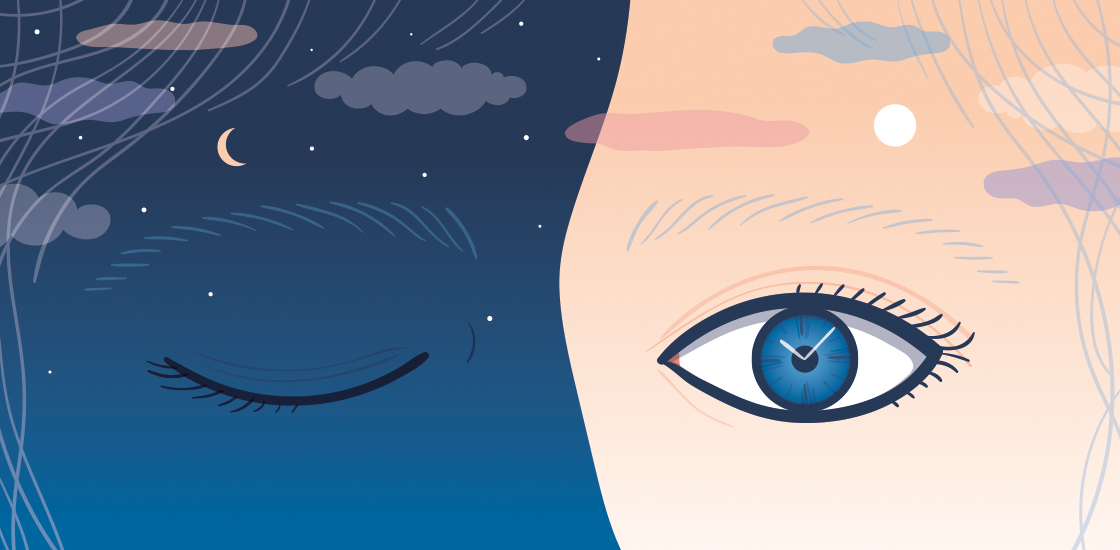Autism may disrupt the body’s circadian clock
Sleep problems in autism may stem from the same biological changes that underlie the core features of the condition.

For many people with autism, sleep doesn’t come naturally. Some have anxiety or behavioral difficulties that make it hard to wind down; others take medications that disrupt sleep. There is, however, mounting evidence that poor sleep may not be just a side effect of autism or its treatments, but rather a central feature of it.
Studies over the past few years suggest that sleep problems may stem from the same mutations that underlie other, more characteristic features of autism.
These changes may disrupt the circadian clock, a molecular timer that keeps cells in sync with the night-day cycle. So far, no evidence ties any of the top autism genes to the circadian clock. But several genetic conditions associated with autism, including tuberous sclerosis, fragile X syndrome and Prader-Willi syndrome, may involve mutations that interfere with the clock.
“This is a very active and needed area of investigation,” says Jonathan Lipton, a pediatric neurologist at the Boston Children’s Hospital Sleep Center.
The circadian clock is a complex of proteins that forms every 24 hours in almost every cell in the body. It helps regulate the expression of genes, turning up to 40 percent of the genome on or off.
The clock controls slumber, cell division and a host of other crucial processes that happen at specific times of day. Mutations or other disruptions that affect the clock can have serious consequences. For instance, the suppression of clock genes in cancer cells has been linked to tumor growth1. And mice with disrupted clocks have problems with memory, metabolism, body temperature regulation and other key processes2,3,4.
Disrupting the clock may have profound effects on the brain and behavior, says Lipton. “We’re starting to understand the clock as a really important focal point,” he says.
Bad timing:
Tuberous sclerosis is a condition associated with autism and is characterized by benign tumors throughout the brain and body. People with tuberous sclerosis have mutations in the genes TSC1 or TSC2, as well as difficulty falling and staying asleep. Mice with TSC1 mutations have unusually short day-night cycles, and their body temperature does not fluctuate throughout the day as it should.
Lipton and his colleagues discovered that mutations in TSC1 in these mice cause levels of a clock protein called BMAL1 to run amok. Lowering the BMAL1 levels normalizes the animals’ rest-activity cycle. The findings suggest that reining in BMAL1 may also alleviate sleep problems in people with the condition5.
Another clock connection to autism involves FMR1, the gene altered in fragile X syndrome. This syndrome is the leading cause of intellectual disability and often involves autism. Like people with fragile X syndrome, fruit flies that lack FMR1 have memory problems and social impairments. When kept in darkness, they also lack a regular sleep-wake cycle, eating and flying at seemingly random times6.
A study last year reported that restoring FMR1 in adult flies resolves the cognitive and social problems, but has no effect on this sleep-wake pattern7. The researchers traced the circadian problems to a set of neurons that produce the hormone insulin. They found that artificially turning FMR1 on in these neurons in the last two days of pupal development normalizes the flies’ day-night rhythm.
Metformin, a diabetes drug that lowers insulin levels, alleviates memory troubles in adult flies but has no effect on the flies’ circadian rhythms, the researchers found. The drug probably needs to be given during development, says Thomas A. Jongens, associate professor of genetics at the University of Pennsylvania, who co-led the study.
Drowsy days:
Researchers have also uncovered genetic ties between autism features and circadian rhythms in people with Prader-Willi syndrome. About one in four people with this genetic condition also have autism. Many individuals with the syndrome are extremely sleepy during the day.
This sleepiness may stem from lack of a chemical messenger called orexin, which stimulates arousal. Mice missing part of the stretch of chromosome 15 deleted in Prader-Willi syndrome produce much less orexin than controls do8. And their sleep is disrupted: They drop continually in and out of sleep throughout the day and night, according to unpublished data from Thomas Scammell’s lab at Harvard University.
The circadian clock in cells is thought to be one of the factors that help regulate the release of orexin throughout the day. In people with Prader-Willi syndrome, the missing genes on chromosome 15 may keep the neurons from making the substance, or making enough of it, through a disruption of the clock. The result may be a lackluster arousal system and excessive daytime drowsiness.
Studying a range of processes governed by the circadian clock in animal models of autism may reveal new targets for treatments to improve sleep. If sleep troubles do stem from the same biological processes as the core features of autism, such treatments could also improve other behaviors associated with the condition.
References:
- Kiessling S. et al. BMC Biol. 15, 13 (2017) PubMed
- Wardlaw S.M. et al. Learn. Mem. 21, 417-423 (2014) PubMed
- Eckel-Mahan K. and P. Sassone-Corsi Physiol. Rev. 93, 107-135 (2013) PubMed
- Karatsoreos I.N. et al. Proc. Natl Acad. Sci. USA 108, 1657-1662 (2011) PubMed
- Lipton J.O. et al. Cell Rep. 20, 868-880 (2017) PubMed
- Dockendorff T.C. et al. Neuron 34, 973-984 (2002) PubMed
- Monyak R.E. et al. Mol. Psychiatry 22, 1140-1148 (2016) PubMed
- Kozlov S.V. Nat. Genet. 39, 1266-1272 (2007) PubMed
Recommended reading

Expediting clinical trials for profound autism: Q&A with Matthew State

Too much or too little brain synchrony may underlie autism subtypes
Explore more from The Transmitter

Mitochondrial ‘landscape’ shifts across human brain


